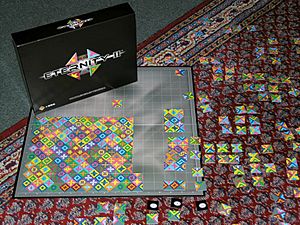Eternity II puzzle facts for kids
The Eternity II puzzle (also known as E2 or E II) is a special kind of edge-matching puzzle. It was first released on July 28, 2007. This puzzle was created by Christopher Monckton. It was sold by TOMY UK Ltd as a follow-up to the first Eternity puzzle. The Eternity II puzzle was part of a big competition. The first person to solve it completely would win a huge prize of $2 million! The competition ended on December 31, 2010, but no one ever found the full solution.
Contents
What is the Eternity II Puzzle?
The Eternity II puzzle is an edge-matching puzzle. This means you have to place many square pieces into a grid. For this puzzle, you need to fit 256 square pieces into a 16 by 16 grid. The main rule is that the edges of touching pieces must match perfectly. The puzzle was made to be very hard to solve, even for powerful computers.
How the Pieces Work
Each puzzle piece has different shapes or colors on its edges. These are called "colors" for short. When you place a piece, its edges must match the edges of the pieces next to it. The other side of each piece is blank and has a number. This side is not used in the puzzle. Each piece can only be turned in 4 different ways.
There are 22 different "colors" in total, not counting the gray edges. Some colors are only found on the outside edges of the puzzle. Other colors are used for the pieces inside the puzzle.
Different Types of Pieces
The puzzle has different kinds of pieces:
- Corner pieces: There are 4 of these. They have two gray sides.
- Border pieces: There are 56 of these. They have one gray side.
- Inner pieces: There are 196 of these. They have four colored sides.
Every piece has a unique design of colors. Also, none of the pieces look the same if you just spin them around. This means each piece and its four possible turns create a different pattern.
Starting the Puzzle
Unlike the first Eternity puzzle, Eternity II has a special starting piece. This piece must be placed in a specific spot near the center of the board. You cannot move or turn this piece.
Clue Puzzles
When the puzzle first came out, there were two smaller "clue puzzles" available. If you solved one of these, it would give you a hint for the main puzzle. This hint would tell you where to place a specific piece on the big board.
- Clue Puzzle 1 was a 36-piece square puzzle (6 by 6).
- Clue Puzzle 2 was a 72-piece rectangle puzzle (12 by 6).
Two more clue puzzles were released in 2008: Clue Puzzle 3 (36 pieces) and Clue Puzzle 4 (72 pieces). The puzzle's rule book said you could solve the main puzzle even without using these hints.
Why the Puzzle is So Hard
The Eternity II puzzle is incredibly difficult to solve. Imagine trying every single possible way to put the pieces together. The number of ways to arrange the pieces is unbelievably huge! Even with the fixed starter piece and other hints, the number of possibilities is still enormous.
To give you an idea, the number of ways to arrange the pieces is more than a 1 followed by 545 zeros! This is a number so big it's hard to even imagine. It's much, much larger than the number of stars in the universe.
The puzzle was designed to have only one or very few correct solutions. This makes it much harder to find the right answer. If there were many solutions, it would be easier to stumble upon one.
The Competition and Its Outcome
The competition for the $2 million prize was a big deal. The first deadline to check solutions was December 31, 2008. At that time, no one had found a complete solution.
However, a prize of $10,000 was given to Louis Verhaard from Sweden. He found a partial solution that had 467 matching edges out of 480 total. He later shared three more partial solutions that were just as good.
The competition officially ended at noon on December 31, 2010. The official Eternity II website announced that no one had won the $2 million prize. The money was never claimed.
To this day, no one has ever publicly shared a verified, complete solution to the Eternity II puzzle. Even Christopher Monckton, the puzzle's creator, has not published his own intended solution. While some fake solutions have appeared online, none have been proven to be correct.


